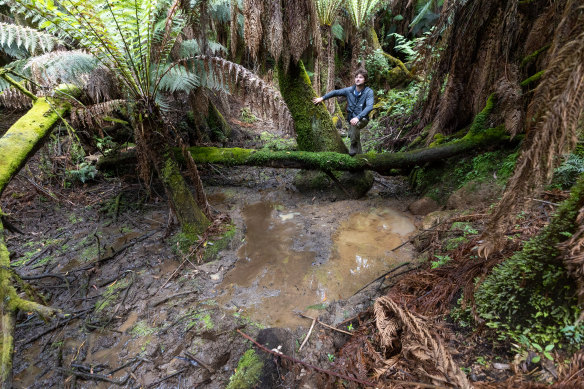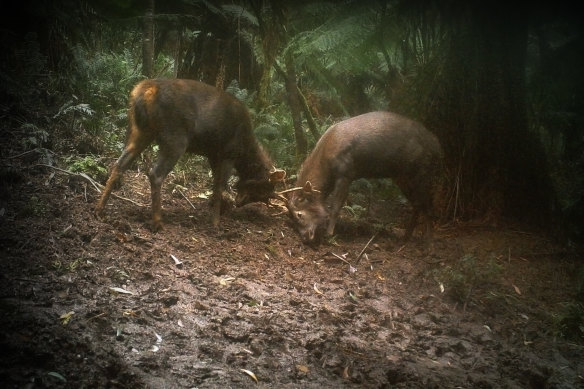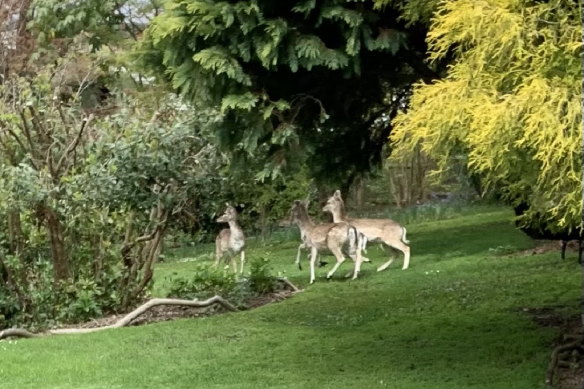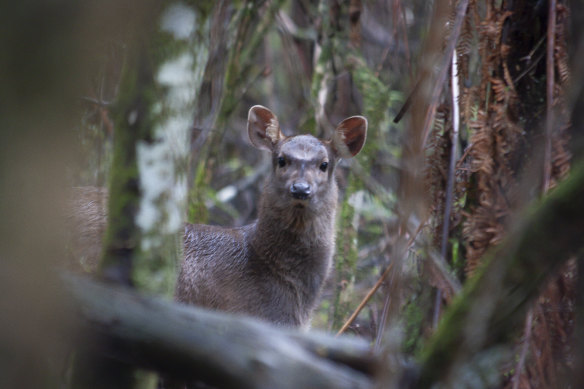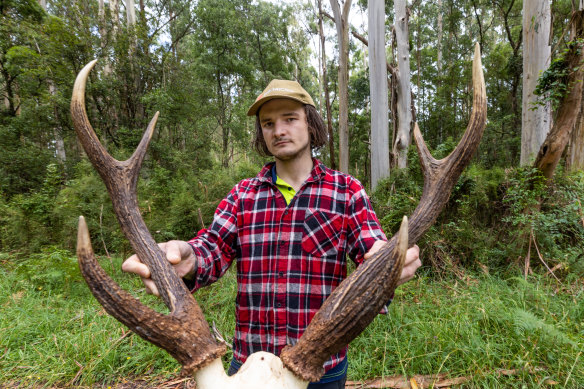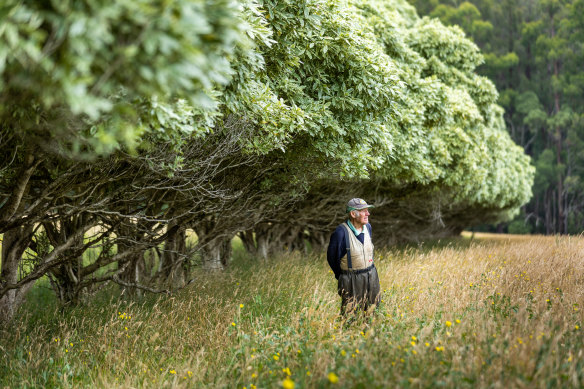Trouble underfoot: feral deer a dire cost to the environment and economy
Key points
- Feral deer populations are exploding, spreading into outer areas of Melbourne and other capital cities.
- The sambar and fallow deer are destroying horticultural and agricultural crops, and damaging ecosystems.
- Victoria and Tasmania still list deer as a protected species, limiting the way the population can be controlled.
Alex Maisey spent many happy hours in his childhood on the banks of Monbulk Creek in the Dandenong Ranges, on the eastern fringe of Melbourne. The water was so clean he had no hesitation in drinking it and the creek banks were furred with soft native mosses.
Scientist Alex Maisey observes the damage deer have done in Sherbrooke Forest, in the Dandenongs, east of Melbourne.Credit:Jason South
But when The Age visited this week with Maisey, who is now an ecologist at La Trobe University, this stretch of creek was a huge, muddy wallowing hole for deer, its bank eroded and pockmarked with holes caused by their hard keratin hooves.
In just two decades, much of this creek and the surrounding Sherbrooke Forest have been damaged by the area’s soaring population of feral sambar and fallow deer.
They wallow in waterways, chew through young vegetation and rub and ringbark native trees with their antlers. As a result, the trees die and the canopy of this cool temperate rainforest is opened up to damaging sunlight.
“They pose a huge threat to biodiversity, and they increase fire risk because their actions are drying out these wet forests,” Maisey says. “They’re terrible for the health of the ecosystem at large.”
Feral deer are spreading into the outer-urban areas of Melbourne, Sydney, Canberra and Brisbane, where they chew their way through gardens and parks, and even cause vehicle collisions. They’re destroying horticultural and agricultural crops, and damaging fragile ecosystems in the Australian alps.
Deer in Sherbrooke Forest, in Victoria’s Dandenongs.Credit:Alex Maisey
The exploding numbers of deer across Australia – approximately a ten-fold increase over 20 years – has prompted a new draft national feral deer plan.
This has been welcomed by the Invasive Species Council, which says deer are one of the most concerning emerging pest species in the country.
Deer were introduced into Australia from Europe in the 19th century as game animals. In 1980, there were about 50,000 feral deer in Australia and by 2002 the population was estimated to have grown to 200,000. Now, the population is likely to have reached more than 2 million.
Deer in residential gardens in the Dandenongs.Credit:Russell Oldham
They are prolific breeders. In good conditions, deer populations can increase by up to 50 per cent each year, meaning that a small herd of 30 deer can grow to 500 in 10 years.
The issue is further complicated because Victoria and Tasmania still list deer as a protected species under wildlife laws, a hangover from when their numbers were low.
“It’s time they were unprotected, so they can be treated as a pest animal like foxes as rabbits,” says Peter Jacobs, a deer project officer with the Invasive Species Council.
“Hunting hasn’t controlled the deer population – it’s not keeping up with the numbers.”
A Frontier Economics report commissioned by the Invasive Species Council found deer would cost the Victorian economy between $1.5 billion and $2.2 billion over the next 30 years.
There are differing views on how soaring deer numbers should be handled. When the national draft plan was released, the Australian Deer Association said it was focused on “generating hysteria and alarmism”, rather than evidence-based management.
A feral deer in Sherbrooke Forrest.Credit:Alex Maisey
“Whilst it’s acknowledged that recreational deer hunting alone is not the only tool required to manage wild deer, deliberately downplaying its role to the point of exclusion is erroneous,” said spokesman Sean Kilkenny.
The association says that in Victoria alone, 200,000 wild deer are harvested annually by recreational hunters.
Landowners can cull deer on private land if they get a permit, while on public land they are the responsibility of government agencies or park authorities.
Nick Barlow is an experienced recreational shooter who culls deer for vineyard owners and other landholders through his not-for-profit business Yarra Valley Deer Management.
Using thermal imagery, he sees native animals like wombats and possums in vineyards and says they only eat a small percentage of the vines, but deer “go through like a mower”.
Deer hunter Nick Barlow who shoots deer for farmers affected by the invasive species.Credit:Jason South
Barlow acknowledges that recreational shooting can’t keep up with the problem, but he’s also concerned that if deer are declared a pest species it will attract inexperienced, dangerous hunters.
On the steep hills near Sherbrooke Forest, horticulturists Mike Edmonds and Rod Endersby have been growing commercial flower crops for 50 years. Last year, $30,000 of their daffodils were decimated by deer, and they were unable to supply thousands of blooms usually produced for the Cancer Council’s Daffodil Day.
“Fifty years ago there was zero damage, but it has become worse and worse,” Edmonds says. “We can’t grow anything out of the back paddock anymore.”
Rob Endersby stands under a hedge planted as a wind break to protect his tulips. The hedge has been eaten by deer and is now useless as a wind break.Credit:Jason South
Maisey would like to see research into biological controls, including ways to suppress deer fertility, or novel approaches, like using Maremma dogs to corral them.
The use of bait is being trialled for deer, but it is not a widespread practice. Foxes and rabbits are baited under regulation, and this has successfully recovered lyrebird populations in the Dandenongs, with survey numbers doubling in two decades.
There are concerns about secondary poisoning of native animals from the use of bait, but Maisey says sodium fluoroacetate, known as “1080”, breaks down quickly and there’s little evidence it remains in the food chain, affecting predators like eagles.
Get to the heart of what’s happening with climate change and the environment. Our fortnightly Environment newsletter brings you the news, the issues and the solutions. Sign up here.
Most Viewed in Environment
From our partners
Source: Read Full Article
